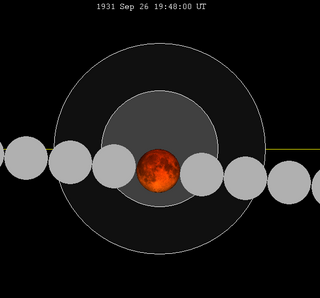
A penumbral lunar eclipse took place on 7 July 2009, the second of four lunar eclipses in 2009. This eclipse entered only the southernmost tip of the penumbral shadow and thus was predicted to be very difficult to observe visually. This lunar eclipse was the predecessor of the solar eclipse of 22 July 2009.

A penumbral lunar eclipse occurred at the Moon’s descending node of orbit on Sunday, May 26, 2002, with an umbral magnitude of −0.2871. A lunar eclipse occurs when the Moon moves into the Earth's shadow, causing the Moon to be darkened. A penumbral lunar eclipse occurs when part or all of the Moon's near side passes into the Earth's penumbra. Unlike a solar eclipse, which can only be viewed from a relatively small area of the world, a lunar eclipse may be viewed from anywhere on the night side of Earth. Occurring about 3.1 days after perigee, the Moon's apparent diameter was larger.

A penumbral lunar eclipse took place on Sunday, January 31, 1999, the first of two lunar eclipses in 1999.

A partial lunar eclipse took place on Saturday, April 15, 1995, the first of two lunar eclipses in 1995, the second being with a penumbral lunar eclipse on Sunday, October 8.
A total lunar eclipse took place on Monday, October 28, 1985, the second of two total lunar eclipses in 1985, the first being on May 4, 1985.

A partial lunar eclipse took place on Saturday, December 21, 1991, the last of four lunar eclipses in 1991. The moon grazed the northern edge of the umbral shadow. It occurred near perigee, and as described, such event was known as a supermoon.

A penumbral lunar eclipse took place on Thursday, June 27, 1991, the second of four lunar eclipses in 1991. The moon entered the Earth's penumbra for about 3 hours, and was difficult to see. This lunar eclipse is the predecessor of the Solar eclipse of July 11, 1991.

A penumbral lunar eclipse took place on Wednesday, January 30, 1991, the first of four lunar eclipses in 1991.
A penumbral lunar eclipse took place on Tuesday, April 14, 1987, the first of two lunar eclipses in 1987, the second being on October 7, 1987. This subtle penumbral eclipse may have been visible to a skilled observer at maximum eclipse. 77.703% of the Moon's disc was partially shaded by the Earth, which caused a gentle shadow gradient across its disc at maximum; the eclipse as a whole lasted 3 hours, 54 minutes and 12.8 seconds. The Moon was just 4.6 days before perigee, making it 0.5% larger than average.
A penumbral lunar eclipse took place on Tuesday, May 15, 1984, the first of three lunar eclipses in 1984. This was a deep penumbral eclipse, with the southern limb of the Moon close to the Earth's shadow.
A penumbral lunar eclipse took place on Tuesday, January 20, 1981, the first of two lunar eclipses in 1981. In a rare total penumbral eclipse, the entire Moon was partially shaded by the Earth, and the shading across the Moon should have been quite visible at maximum eclipse. The penumbral phase lasted for 4 hours and 24 minutes in all, though for most of it, the eclipse was extremely difficult, if not impossible to see. The moon's apparent diameter was larger because the eclipse occurred 5.2 days after perigee.
A penumbral lunar eclipse took place on Sunday, July 27, 1980, the second of three penumbral lunar eclipses in 1980. This very subtle penumbral eclipse was essentially invisible to the naked eye; though it lasted 2 hours, 17 minutes and 36.3 seconds, just 25.354% of the Moon's disc was in partial shadow. The moon passed in the northern edge of the Earth's penumbral shadow, and was the 70th lunar eclipse of Saros cycle 109.

A penumbral lunar eclipse occurred on Friday, 5 May 2023, the first of two lunar eclipses in 2023. The moon's apparent diameter was 0.1% larger than average since it occurred 5.5 days before perigee. This was the deepest penumbral eclipse since February 2017 and until September 2042.

A penumbral lunar eclipse will take place on Tuesday 17 August 2027. It will cause a subtle dimming as 54.56% of the Moon will cross within Earth's penumbral shadow.

A penumbral lunar eclipse will take place on Sunday, 18 July 2027. The Moon will barely clip the edge of the Earth's penumbral shadow, and the eclipse will be impossible to see in practice. The event is listed as a miss by some sources.

A partial lunar eclipse will take place on November 30, 2039. At 3 hours 26 minutes, it is the longest partial lunar eclipse since November 19, 2021, which is the previous member of Lunar Saros 126.
A penumbral lunar eclipse took place on Sunday, July 15, 1973, the third of four lunar eclipses in 1973, the first was a penumbral lunar eclipse on Thursday, January 18, the second was a penumbral lunar eclipse on Friday, June 15, and the last being with a partial lunar eclipse on Monday, December 10.

A total lunar eclipse took place on Wednesday, October 18, 1967, the second of two total lunar eclipses in 1967, the first being on April 24, 1967.

A total lunar eclipse will take place on September 19, 2043.

A total lunar eclipse took place on Saturday, September 26, 1931. The Moon passed through the central of the Earth's shadow. This was the last central lunar eclipse of Saros cycle 126.




































